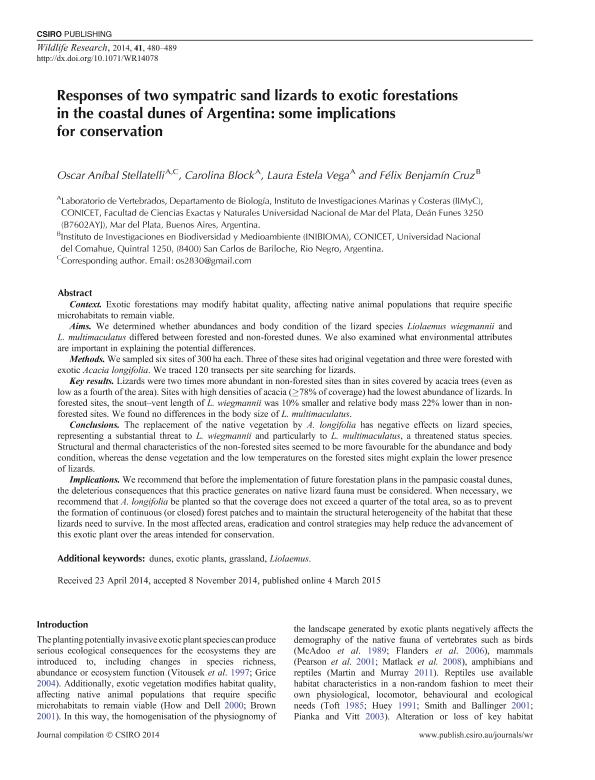Mostrar el registro sencillo del ítem
dc.contributor.author
Stellatelli, Oscar Aníbal

dc.contributor.author
Block, Carolina

dc.contributor.author
Vega, Laura Estela
dc.contributor.author
Cruz, Felix Benjamin

dc.date.available
2017-01-26T21:06:20Z
dc.date.issued
2015-03
dc.identifier.citation
Stellatelli, Oscar Aníbal; Block, Carolina; Vega, Laura Estela; Cruz, Felix Benjamin; Responses of two sympatric sand lizards to exotic forestations in the coastal dunes of Argentina: some implications for conservation; Csiro Publishing; Wildlife Research; 41; 6; 3-2015; 480-489
dc.identifier.issn
1035-3712
dc.identifier.uri
http://hdl.handle.net/11336/12058
dc.description.abstract
Context. Exotic forestations may modify habitat quality, affecting native animal populations that require specific microhabitats to remain viable. Aims. We determined whether abundances and body condition of the lizard species Liolaemus wiegmannii and L. multimaculatus differed between forested and non-forested dunes. We also examined what environmental attributes are important in explaining the potential differences. Methods. We sampled six sites of 300 ha each. Three of these sites had original vegetation and three were forested with exotic Acacia longifolia. We traced 120 transects per site searching for lizards. Key results. Lizards were two times more abundant in non-forested sites than in sites covered by acacia trees (even as low as a fourth of the area). Sites with high densities of acacia ( 78% of coverage) had the lowest abundance of lizards. In forested sites, the snout–vent length of L. wiegmannii was 10% smaller and relative body mass 22% lower than in nonforested sites. We found no differences in the body size of L. multimaculatus. Conclusions. The replacement of the native vegetation by A. longifolia has negative effects on lizard species, representing a substantial threat to L. wiegmannii and particularly to L. multimaculatus, a threatened status species. Structural and thermal characteristics of the non-forested sites seemed to be more favourable for the abundance and body condition, whereas the dense vegetation and the low temperatures on the forested sites might explain the lower presence of lizards. Implications. We recommend that before the implementation of future forestation plans in the pampasic coastal dunes, the deleterious consequences that this practice generates on native lizard fauna must be considered. When necessary, we recommend that A. longifolia be planted so that the coverage does not exceed a quarter of the total area, so as to prevent the formation of continuous (or closed) forest patches and to maintain the structural heterogeneity of the habitat that these lizards need to survive. In the most affected areas, eradication and control strategies may help reduce the advancement of this exotic plant over the areas intended for conservation.
dc.format
application/pdf
dc.language.iso
spa
dc.publisher
Csiro Publishing

dc.rights
info:eu-repo/semantics/openAccess
dc.rights.uri
https://creativecommons.org/licenses/by-nc-sa/2.5/ar/
dc.subject
Dunes
dc.subject
Exotic Plants
dc.subject
Grasslands
dc.subject
Liolaemus
dc.subject
Lizard
dc.subject.classification
Ecología

dc.subject.classification
Ciencias Biológicas

dc.subject.classification
CIENCIAS NATURALES Y EXACTAS

dc.title
Responses of two sympatric sand lizards to exotic forestations in the coastal dunes of Argentina: some implications for conservation
dc.type
info:eu-repo/semantics/article
dc.type
info:ar-repo/semantics/artículo
dc.type
info:eu-repo/semantics/publishedVersion
dc.date.updated
2016-12-12T14:30:10Z
dc.journal.volume
41
dc.journal.number
6
dc.journal.pagination
480-489
dc.journal.pais
Australia

dc.journal.ciudad
Clayton
dc.description.fil
Fil: Stellatelli, Oscar Aníbal. Consejo Nacional de Investigaciones Científicas y Técnicas. Centro Científico Tecnológico Mar del Plata. Instituto de Investigaciones Marinas y Costeras; Argentina. Universidad Nacional de Mar del Plata. Facultad de Cs.exactas y Naturales. Departamento de Biologia. Laboratorio de Vertebrados; Argentina
dc.description.fil
Fil: Block, Carolina. Consejo Nacional de Investigaciones Científicas y Técnicas. Centro Científico Tecnológico Mar del Plata. Instituto de Investigaciones Marinas y Costeras; Argentina. Universidad Nacional de Mar del Plata. Facultad de Cs.exactas y Naturales. Departamento de Biologia. Laboratorio de Vertebrados; Argentina
dc.description.fil
Fil: Vega, Laura Estela. Consejo Nacional de Investigaciones Científicas y Técnicas. Centro Científico Tecnológico Mar del Plata. Instituto de Investigaciones Marinas y Costeras. Subsede Instituto Nacional de Investigación y Desarrollo Pesquero; Argentina. Universidad de Buenos Aires. Facultad de Cs.exactas y Naturales. Departamento de Biodiversidad y Biologia Experimental. Laboratorio de Vertebrados; Argentina
dc.description.fil
Fil: Cruz, Felix Benjamin. Consejo Nacional de Investigaciones Científicas y Técnicas. Centro Científico Tecnológico Patagonia Norte. Instituto de Investigación En Biodiversidad y Medioambiente; Argentina. Universidad Nacional del Comahue; Argentina
dc.journal.title
Wildlife Research

dc.relation.alternativeid
info:eu-repo/semantics/altIdentifier/url/http://www.publish.csiro.au/wr/WR14078
dc.relation.alternativeid
info:eu-repo/semantics/altIdentifier/doi/http://dx.doi.org/10.1071/WR14078
Archivos asociados
